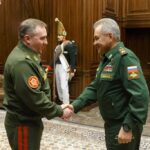A week after the first anniversary of the signing of the trilateral peace agreement ending the hostilities of the second Nagorno-Karabakh war – signed by Armenian Prime Minister Nikol Pashinyan, Azerbaijani President Ilham Aliyev, and Russian President Vladimir Putin – a new set of clashes broke out between Armenia and Azerbaijan. While brief, especially compared to the previous 44 days of fighting, the hostilities were not only destructive in that they claimed several lives and wounded many others, but they also undermined the limited diplomatic progress that had been made in the last year. Although little had been achieved in the post-war period, the outbreak of hostilities certainly does not encourage Armenia and Azerbaijan to make any agreements on regional development.
There were multiple causes for the recent escalation between Armenia and Azerbaijan. On one front, it was reported that Azerbaijani forces killed an Armenian civilian and wounded three others near Shusha on November 8. In retaliation for this, a civilian from Nagorno-Karabakh threw an unspecified explosive device at an Azerbaijani military checkpoint near the Lachin corridor, injuring one Azerbaijani serviceman. By November 14, the Ministry of Defense of Azerbaijan announced that a “concentration of a group of personnel and equipment of the Armenian Armed Forces” had been observed as well as “preparation for provocation.” According to Azerbaijani officials, the situation was diffused and Armenian forces withdrew from the area.
Another facet contributing to the increase in tensions between Armenia and Azerbaijan relates back to connectivity and transportation linkages in the post-war environment. For several months, Azerbaijan has been protesting Iranian trucks entering Nagorno-Karabakh via Azerbaijani territories, as well as the lack of a response from Russian peacekeepers on this issue. In response to this, Azerbaijan established several checkpoints along roadways, including the Goris-Kapan road, which restricted the movement of Armenians living in this area.
Azerbaijan has also expressed growing frustration over the lack of progress in developing a transportation corridor between Azerbaijan proper and its exclave of Nakhchivan. Rumors circulated that an agreement on this issue would be signed by Prime Minister Pashinyan and President Aliyev near the anniversary date of the signing of the trilateral agreement, but no action materialized. It has been speculated that Armenia possibly withdrew from an agreement on this issue, citing concerns over the control and management of any routes passing through its sovereign territory, angering Azerbaijan.
Full fighting broke out between the two countries on November 15. Armenian officials state that the fighting took place near Sev Lake in the Syunik Province, which is clearly recognized as territory of the Republic of Armenia. Azerbaijani officials, however, state that the recent skirmishes were located in the area near Kelbajar and Lachin, which would be within the borders of Azerbaijan. Russian sources indicate that the ‘situation’ occurred near Mount Kilisali, located in Kelbajar, Azerbaijan.
Although there are differences in the reporting of where the fighting actually took place, it is important to note that Armenia called upon Russia for support, but Russia did not respond militarily. This likely indicates that the fighting did not take place in the territory of Armenia, as Russia would have been obliged to intervene to support the territorial integrity of Armenia. However, it could also be another example of Russia acting aloof in defending the state in which it has signed several defense treaties with.
On November 16, the fighting was said to have ‘stabilized’ after Russian Defense Minister Sergey Shoigu held a phone meeting with the Ministers of Defense of Armenia and Azerbaijan. With Russia’s mediation, a new ceasefire was agreed upon and went into effect at 18:30 (local time) on November 16.
As of the time of writing, the Armenian Ministry of Defense is reporting that 1 soldier was killed, 13 were captured by Azerbaijani forces, and the location of 24 other servicemen is unknown. Eduard Aghajanian, Chairman of the Armenian Parliamentary Committee on Foreign Relations, stated that 15 Armenian soldiers had been killed, contradicting the official announcement of the Ministry of Defense. The Azerbaijani Ministry of Defense has stated that 7 servicemen were killed and another 10 were injured.
One day later, the newly brokered ceasefire is holding, and Armenia and Azerbaijan are facing new pressure from the international community to refrain from fighting. The United States State Department issued a statement urging both sides to reduce tensions and avoid further escalation. The State Department reiterated the need for both sides to abide by the statement of the Minsk Group Co-Chairs, which also calls for “direct dialogue aimed at contributing to security, stability, and prosperity in the region.”
Very little was achieved during the past year between Armenia and Azerbaijan diplomatically. One year is simply not enough to restore confidence after 30 years of conflict, however, this two-day skirmish sets both parties back. Negotiations will stall even further, delaying the prospects of any further development, ultimately negatively impacting the people of Armenia and Azerbaijan.

